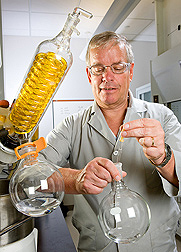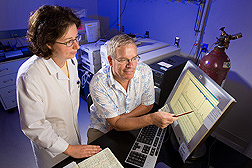Uncovering the Nutritional Value of Oats
|
|
Oats have been widely touted for their many health benefits to humans. In part, these benefits are likely derived from avenanthramides (Avns), a metabolite with potent antioxidant properties found exclusively, among food crops, in oats.
At the Cereal Crops Research Unit in Madison, Wisconsin, chemist Mitchell Wise is exploring the full extent of the biological function Avns have in oats. Previous studies have found that an Avn-enriched diet boosted antioxidant activity in serum and certain tissues in mammals, including humans. Insight into how Avn production is regulated may lead to increased Avn levels in the grain, which could, in turn, lead to higher antioxidant levels in the foods we eat.
The specific purpose of Avns is still largely unknown, but previous studies have found an increased production of Avns in oat leaves when the plant is attacked by a fungus, leading researchers to believe it plays an antimicrobial role.
But the amounts of individual Avns, says Wise, are highly variable and appear to be strongly affected by environment, genotype, and genotype-environment interactions. Wise and colleague Doug Doehlert, a fellow chemist with the ARS Red River Valley Agricultural Research Center in Fargo, North Dakota, examined the correlation between crown rust pressure and Avn concentration in the grain. They tested 16 oat cultivars and 2 breeding lines at three locations in North Dakota over 2 years.
|
|
The researchers found genotypes with the strongest crown rust resistance typically had the highest Avn concentrations in environments where crown rust occurred. They also found Avn production is likely influenced by additional environmental factors, as not all cultivars with strong crown rust resistance produced high Avn concentrations. Nevertheless, their results suggest that oat breeders—taking into account crown rust pressure during growth—can select certain cultivars for enhanced production of Avns.
Wise is also making an important contribution to human nutrition studies involving oats. Though there are at least 25 structural varieties of Avns found in oats, three forms—avnA, avnB, and avnC—are most abundant in the grain. Wise is able to create pure synthetic compounds of each type, which he supplies to colleagues for use in nutrition studies. Recently, Avns have been found to help reduce the risk of heart disease. (See story on Oats: Cooling Inflammation and Unhealthy Cell Proliferation in this issue.)
In his lab, Wise is further researching the biosynthesis of Avns. He developed a suspension culture system from oat shoot tissue in which Avns are produced in response to a chemical that mimics fungal infection. The suspension cultures produce large amounts of avnA and avnG and, under certain culture conditions, avnB and avnC.
“This system is a new tool that can be used for more detailed investigation into how certain Avns are produced,” says Wise. “Once refined, the system has the potential to create individual Avns for further study.”—By Stephanie Yao, Agricultural Research Service Information Staff.
This research is part of Plant Biological and Molecular Processes, an ARS national program (#302) described at www.nps.ars.usda.gov.
Mitchell Wise is in the USDA-ARS Cereal Crops Research Unit, 502 Walnut St., Madison, WI 53726-2335; (608) 262-9242.
"Uncovering the Nutritional Value of Oats" was published in the February 2010 issue of Agricultural Research magazine.








